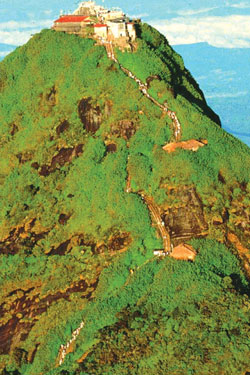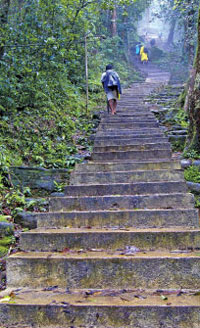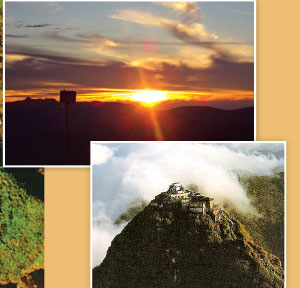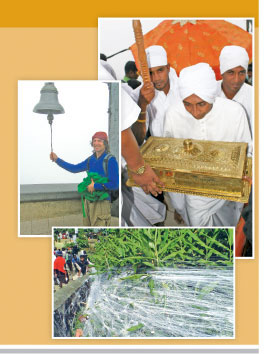|
* it's the height of the pilgrim season now:
How Sri Pada was
first lit
Sri Pada pilgrim season starts on Unduvap Full Moon Day (December)
when the image of God Saman and other sacred objects of worship are
ceremonially taken up to the shrine atop the peak. From then on, the
pilgrims' trek begins with the number of pilgrims increasing with each
day. The pilgrim season is presently in its
  third
month. Now is the height of the season, that is, from the Navam
Full-Moon Poya (February) to about a fortnight after the Medin Full Moon
Poya (March). Now, the weather around the peak is at its best; no rains,
no strong winds, a cloudless sky, warm by day and cold at night - not a
biting cold as in December and January. third
month. Now is the height of the season, that is, from the Navam
Full-Moon Poya (February) to about a fortnight after the Medin Full Moon
Poya (March). Now, the weather around the peak is at its best; no rains,
no strong winds, a cloudless sky, warm by day and cold at night - not a
biting cold as in December and January.
With the waning of the Medin moon, the number of pilgrims gradually
gets less and less. Although the pilgrim season ceremonially ends at
Vesak, a few make the pilgrimage after the Bak Full Moon (April),
because, at this time the Bak maha akunu the claps of thunder
accompanied by lightning starts. It is a sign that the inter-monsoon
rains are coming.
From ancient times pilgrims have climbed this holy mountain by torch
light, each group of pilgrims carrying one or more pandum. The pandum is
made by winding long straps of cloth round and round a hardy stick. This
was dipped in oil and lit. When the pilgrim was a wealthy man or an
important person, the torch was carried in front by a servant.
After the opening of the tea plantations, the kerosene lantern, also
called the hurrican lamp became a household item.
These were readily available in any small town and pilgrims climbed
by the light of these lanterns called lantayrum in Sinhala.
All that is now history. The pandum and the lantayruma (lantern) are
in limbo. The whole peak has been lit up by electricity.
When the lights were switched on for the first time on October 5,
1950 it was a fulfilment of a vow made by the Government, invoking the
help of God Saman, the guardian of the holy mountain, to expedite and
complete the hydro-electric scheme, begun in the 1920. The work on this
scheme was stalling ever so often. After 30 years the work was complete
and lighting the holy mountain was an offering to the Buddha and to God
Saman. This was not the first time that the shrine atop the peak and the
surrounding area were lit up by electricity. Sixteen years earlier a
group of energetic devotees of Saman Deviyo had by their own efforts and
at their own expense, provided light to the precincts of the shrine and
the last lap of the climb, from Maha Giri Dombaya.

Very few know when and by whom it was done, for it was the work of a
few devotees of Saman Deviyo whose one aim was to serve the pilgrims and
to gain merit.
They were, not after publicity or honours. I myself learnt of this
great act of devotion on reading two articles in the Silumina and Budu
Sarana, both Lake House publications.
Here's how the story goes...
|

Making the arduous climb to the Holy Mountain. |
Why back in 1930, a young couple, Mawarala Vitharanage Eliyas
Appuhamy and his wife went on a pilgrimage to Sri Pada with their 18
month infant daughter. Being first timers to Sri Pada, Wannaku Guruge
Sarrdis Happuhamy, accompanied them as their guide - nadday gura .
At Seetha Gangula they, like all pilgrims, washed themselves and
rested awhile before beginning the climbs. When they reached the shrine
it was dark. Eliyas Appuhamy who had carried the infant all the way up
was tired. He put his foot on a pile of gunny bags and rested the infant
on his thigh.
In a trice (instantly), the pile began to move and Appuhamy heard a
voice from inside the gunny bags asking in Tamil "Ennah Aiyya?" (What
Sir?).
Appuhamy realised he had stepped on a man, who to escape the biting
cold had huddled inside gunny bags. He apologised, but he was said. He
thought that in this sacred place he had trampled another human being
mistaking him for pile of gunny bags, woried him.
The mistake he realised was due to the darkness everywhere. Then and
there he resolved (made a firm decision) to light up the shrine and the
surrounding area. On the way down he told Saranelis Appuhamy of his
decision and plan.
Back home in Wellawatta, Colombo, Eliyas Appuhamy and Sararelis
Appuhamy told a few friends of their plan to light up the Sri Pada
Maluwa. It was a gigantic project, but Eliyas Appuhamy was confident it
could be done.
He spoke to many more relations and acquaintances and got them
interested in the project, and by 1933 he was able to muster (bring
together) enough people to form a society.
The society inaugurated on March 26, 1933 was named Samanta Koota
Viduali Pahan Aloka Sahodara Samitiya (Brotherhood for the lighting up
of Samanta Koota Saman's mountain). When the society was collecting
money for their project, Walker Co, advertised a 5 h.p. dynamo for sale.
The selling price was Rs. 1,500. The society didn't have enough money.
So, Eliyas Appuhamy mortgaged his bus which was his only source of
income, and Sarnelis Appuhamy made good the balance.
The dynamo was taken by cart in a procession to Kegalle and from
there in Elayis Appuhamy's brother's bus to Nallatanniya at the foot of
the peak.
Now was the most difficult part of the transportation. An elephant
was hired for this purpose. The dynamo was hung round the elephant's
neck and he walked slowly and carefully up the pilgrims' path.
Fixing the dynamo in a shed, planting posts to carry the wires,
wiring and all other work was done under the supervision of a Burgher
engineer named Ferguson, hired by Eliyas Appuhamy, Saranelis Appuhamy,
and R.E. Wijesekera owner of Vijaya Stores Kollupitiya.
All work was completed by mid February 1934, and on Navam Full Moon
Poya Day, February 28. Sam Elapatha Disawa, the Trustee of Sri Pada
switched on the lights around 6 p.m. and jubilant cries of "Sadhu Sadhu"
reverberated through the crowd.Now, for the first time, the shrine, the
surrounding area and the pilgrim path was bathed in light and it was
possible to do the last lap of the climb from Maha Giri Dambaya without
torches or hurricane lamps.
Switching on the lights was the culmination of the Brotherhood's aim.
Their aim had been achieved, but the work was not yet over. For 16 years
until the Government lighted up the peak on October 3, 1952, two or
three members of the society went up to the peak every year to work the
dynamo and stayed till the season ended.
What the Sahodara Samitiya did was a tremendous achievement and an
act of supreme devotion to the Buddha and God Saman. No plaque no
inscription records the valiant effort, determination and devotion of
these few men; small-time business men, who proved true the old saying,
'where there is a will there is a way'.
Sumana Saparamadu
***********
[ Fact file ]
* The hallowed mountain, which is shrouded in legend and history, is
situated 16 km. North-East of Ratnapura at an altitude of 2,243m. (7,360
ft.) above sea level.

* In Buddhist tradition, it is believed to be the footprint of the
Buddha, in Hindu tradition, that of Shiva and in Christian tradition
that of Adam.Some Muslims too believe this.
* According to Sri Lanka's great chronicle, Mahawamsa , Buddha
visited Sri Lanka three times. The last time he travelled from Kelaniya
to Sri Pada, and then to Digavaphi. It is believed by the Buddhists that
the Buddha left his footprint on the rock at top of the mountain at the
invitation of God Saman (Saman Deviyo ).
* The real footprint on Adam's Peak is believed to be set in jewels
beneath the visible rock.
* The first historical mention about Sri Pada comes during the reign
of Vijayabahu (1055-1110).
* Pilgrims are supposed to ring the bell at the peak equivalent to
the number of times he has visited the peak.They also tie a thread at
Indikatu paya.
* Alexander the Great, Greek warrior king and empire builder is
believed to have visited Sri Pada (circa. 324 B.C.), the peak was
already held in veneration. Ashraff the 15th century poet describes this
odyssey of Alexander to Sri Pada in his 'Zaffer Namah Skendari' . After
landing in the Island he and his retinue explores the wonders of the
Island.
Here Alexander is known to have sought the assistance of the
Philosopher Bolinas, a celebrated Greek occultist and magician, to climb
the Sacred peak, then supposed to be zealously guarded by various
deities. Among the artefacts devised to ascend the then almost
inaccessible peak were massive iron chains affixed to stanchions of the
same metal secured to the bare rock face.
The chains were secured to the stanchions with rivets of iron and
bronze. Remains of these artefacts are still evident. Early pilgrims to
the peak made use of these chains to hoist themselves upto the summit.
* Arab pilgrim Ibn Batuta alias Abu Abdullah Mohammed (1304-1377),
had ventured to reach the summit of the holy mountain via Ratnapura
* The renowned Venetian merchant and traveller, Marco Polo
(1254-1324), too had ascended the mountain to pay homage to the glorious
Foot of Adam, on his way from China in 1292, before returning to Venice.
It was while in China that he had come to know about the sacred footmark
from Kublai Khan, the first Emperor of the Yuan dynasty in China.
* Sri Pada is also called Samanalakanda-butterfly mountain.

* Access to the mountain is possible by six trails -
Ratnapura-Palabaddala, Hatton-Nallathanni, Kuruwita-Erathna, Murraywatte,
Mookuwatte and Malimboda.
* Sri Pada is the term derived from Sanskrit and is used by the
Sinhalese in a religious context. Translated roughly it means the sacred
footprint.
* Other local and historic names include Ratnagiri ("jewelled hill"),
Samantakuta ("Peak of Saman"), Svargarohanam ("the climb to heaven"),
Mount Rohana and other variations on the root Rohana.
Facts and pix- Internet |

